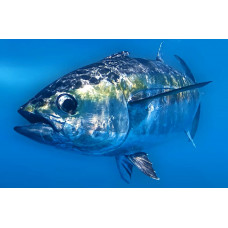Latin name
Thunnus orientalis
Other names
Thunnus orientalis
Identification
The fish has an elongated, spindle-shaped body that tapers sharply towards the tail. The height of the body is 3.2-4.3 times the length of the body. The length of the head is 3.2-3.5 times less than the length of the body. The body is almost circular in cross section. The lateral line is undulated.
Head large, conical, eyes small, mouth large with a row of small pointed teeth on each jaw. In adults the eyes are small. The posterior edge of the maxilla passes behind the vertical of the anterior edge of the eye. Fleshy outgrowths of the outer part of the olfactory capsule are undeveloped. The folds of the mucous membrane have no notches at the edges and are well defined.
The lower surface of the liver is radially striated. There is a swim bladder. Vertebrae 18+21=39. In the anterior part of the body, the skin is covered with scales, which are greatly enlarged along the lateral line, forming a carapace.
Features of fish fins
The pectoral fins are 4.8-6 times smaller than the body length. The two dorsal fins are close together. The first dorsal fin is long, with a concave edge, and can fold into a groove running along the back. The second dorsal fin is shorter, crescent-shaped, similar to the anal fin. The pelvic fins are small and pointed. Between the second dorsal and caudal fins are 8-10 small extra fins. The anal fin has 13-16 soft rays. There are 7-9 additional fins between the anal and caudal fins. In individuals over 2 m long, the dorsal and anal fins are elongated. The caudal peduncle is elongated with three stabilising horizontal carinae on each side: a large central one and two small ones on either side.
Sailing speed
They are in constant motion. When they stop, they have difficulty breathing because the gill lids open to match the lateral movements of the body to the left and right. Water only enters the gill cavities through the open mouth when in motion. These fish can reach speeds of up to 20-30 kilometres per hour for short periods. The main locomotor function is performed by the caudal fin and the short, streamlined body remains almost motionless.
Fish colouring
Colouring characteristic of pelagic fishes: dorsal surface of body dark blue, upper part of sides greenish, sometimes with transverse rows of pale spots, ventral side bright. The first dorsal fin is yellow or blue, the second dorsal and anal fins are brown. Other fins are yellow with dark edges. The pectoral fins are small and pointed, not reaching the gap between the dorsal fins. In juveniles, the flanks are covered with more than 10 transverse dark stripes.
Distribution
Found mainly in the North Pacific Ocean from East Asia to the coast of North America. They are caught in the waters of Australia, Canada, China, Ecuador, Guam, Japan, Korea, Mexico, Papua New Guinea, Taiwan and the United States.
Habitat
These pelagic fish are more commonly found in temperate coastal waters and usually do not descend below 200 metres, although there is evidence that they can be found as deep as 550 metres.
Size
The largest ever caught was 3 metres long and the heaviest weight 450 kg. Two metre long tunas are not uncommon.
Behavior
Gregarious fish that make long migrations. They sometimes form schools with tuna of similar size. They spawn in the north-western part of the Philippine Sea (off Honshu, Okinawa and Taiwan) and in the Sea of Japan. Part of a single population migrates to the eastern Pacific and returns to the spawning area after several years. Sometimes they swim to the southern hemisphere, to the coasts of Australia, New Zealand, French Polynesia and the Gulf of Papua.
Food and feeding habits
The diet is varied and depends on the food base in the fattening areas. It is based on gregarious pelagic fish living near the surface (sardines, mackerel, anchovies, sprats, herring) and cephalopods. They sometimes eat crabs.
Reproduction
They reproduce by spawning. Fecundity depends on the size of the female and ranges from 5 million to 25 million eggs. The spawning season lasts from April to August, but the exact time varies from region to region. Tuna spawn earlier in the northwestern Philippine Sea and later in the Sea of Japan. They reach sexual maturity at five years of age. Generation length is estimated at 7-9 years and life expectancy at 15 and 26 years according to two independent sources. Sexually mature fish average 1.5 m in length and 60 kg in weight.
Fishing
An important commercial object. Valued by amateur fishermen.
Relationship with a person
The meat is a delicacy. It is considered the best raw material for sushi and sashimi. The raw meat is dark red in colour, but becomes white or ivory when cooked. The texture is dense and similar to beef.
| Classification | |
| Phylum | Chordata |
| Class | Actinopterygii |
| Squad | Scombriformes |
| Family | Scombridae |
| Genus | Thunnus |
| Species | T. orientalis |
| Features | |
| Conservation status | Near Threatened |
| Habitat | Pelagic |
| Life span, years | 26 |
| Maximum body weight, kg | 450 |
| Maximum length, cm | 300 |
| Sailing speed, m/s | 8,3 |
| Threat to people | Edible |
| Way of eating | Predator |
Pacific bluefin tuna
Tags: pacific bluefin tuna



